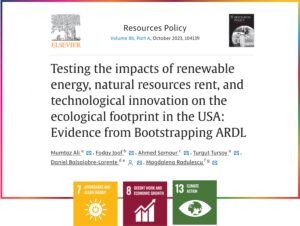
A collaborative research effort, including a co-authors Ali and Tursoy from Near East University, has delved into the complex relationship between natural resources, technological innovation, renewable energy, and economic growth, and their impact on environmental quality in the United States. Spanning from 1970 to 2019, the study utilized innovative econometric techniques to explore this nexus and provide valuable insights for policymakers.
The findings, obtained through Bootstrap ARDL estimation, unveiled intriguing dynamics. While renewable energy sources were found to positively influence environmental quality, the exploitation of natural resources had a detrimental effect. Additionally, technological innovation emerged as a significant factor associated with ecological sustainability, highlighting its pivotal role in shaping environmental outcomes.
The study underscores the importance of policy interventions aimed at promoting sustainable growth, particularly in the aftermath of the COVID-19 pandemic. Recommendations include fostering the adoption of innovative technologies and incentivizing the transition towards renewable energy alternatives to mitigate ecological footprints. By prioritizing these initiatives, the United States can pursue a path towards sustainable economic development while safeguarding environmental integrity.
Moreover, the study emphasizes the need for prudent management of natural resources to minimize adverse environmental impacts. Recognizing the inherent trade-offs between economic development and environmental conservation, policymakers are urged to implement strategies that balance resource extraction with environmental protection measures.
This collaborative research endeavor provides valuable insights into the complex interplay between natural resources, technological innovation, renewable energy, and environmental quality in the United States. By shedding light on these relationships, the study offers actionable recommendations to guide policymakers in steering the nation towards a more sustainable and resilient future.
More Information:
https://www.sciencedirect.com/science/article/pii/S0301420723008504